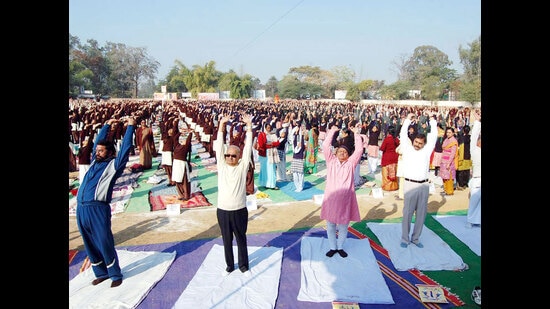Yoga: A powerful tool to improve health
On the International Day of Yoga, WHO is privileged to celebrate the physical and mental health benefits of yoga and highlight its contributions to lifelong health and well-being, promoting healthier populations, and a healthier, more equitable and sustainable region and the world
The theme of this year’s International Day of Yoga is “Yoga for humanity” — a theme both fitting and timely. Yoga is beneficial for people of all ages and incomes. It can be practised anywhere, at any time, and by people of all countries and cultures. Yoga is a powerful tool for individuals, communities and countries to improve not only physical but also mental health, and to prevent and control non-communicable diseases (NCDs) — one of the World Health Organization (WHO)’s South-East Asia Region’s eight flagship priorities. The four major NCDs — cardiovascular diseases, cancer, chronic respiratory diseases and diabetes — account for more than 80% of all premature NCD deaths, of which 85% occur in low- and middle-income countries, including in the region.

Schools, workplaces, civil society organisations and communities should consider incorporating yoga into daily activities, supporting each country’s mission to achieve a 15% relative reduction in physical inactivity by 2030 — the Sustainable Development Goals (SDG) target. Where appropriate, health care providers should encourage patients to adopt yoga to promote health, prevent and manage diseases — including NCDs — and accelerate recovery from ill-health and injuries.
Notably, yoga has been shown to have immediate psychological benefits, and increasing feelings of emotional and social well-being. Unlike other forms of physical activity, yoga can help lower heart rate and activate the parasympathetic nervous system. It can even be performed by people who are sick. Throughout the Covid-19 response, yoga has helped hundreds of millions of people from all countries and cultures stay healthy and well, consistent with the conviction — expressed in WHO’s constitution — that health is not merely the absence of disease or infirmity, but rather a state of complete physical, mental and social well-being.
On the International Day of Yoga, WHO is privileged to celebrate the physical and mental health benefits of yoga and highlight its contributions to lifelong health and well-being, promoting healthier populations, and a healthier, more equitable and sustainable region and the world.
And we keenly observe: Yoga is just one of many systems and/or forms of knowledge, skills or practices used in the region to prevent, diagnose, improve or treat physical and mental illness, and which may be integrated into preventive and promotive health strategies at the primary health care level, as highlighted in the region’s new Strategy for Primary Health Care.
The global momentum is growing, and is being led by our region. In March, WHO and the Government of India (GoI) signed an agreement to establish the WHO Global Centre for Traditional Medicine (GCTM) in Jamnagar, India. GCTM — which is supported by an investment of $250 million from GoI — has a strategic focus on evidence and learning, data and analytics, sustainability and equity, and innovation and technology, with the overall aim of optimising the contribution of traditional medicine (TRM) to global health and sustainable development.
GCTM’s vision is well aligned with the region’s focus on strengthening TRM system-performance monitoring, increasing safety monitoring for TRM products, enhancing research capacity on TRM, and integrating safe and effective TRM into health service delivery. It will contribute significantly to regional and global efforts to leverage safe, effective and evidence-based TRM to help achieve universal health coverage (UHC), the flagship priority and SDG target that underpins all others. In the region’s quest to prevent and control NCDs and achieve UHC, WHO will continue to highlight the physical and mental health benefits of yoga and support research on systems and/or forms of traditional knowledge, skills and practice. Together, let us unite ancient wisdom with modern science, for a healthier, happier and more stress-free future for all of humanity.
Poonam Khetrapal Singh is regional director, WHO Southeast Asia The views expressed are personal
Continue reading with HT Premium Subscription




